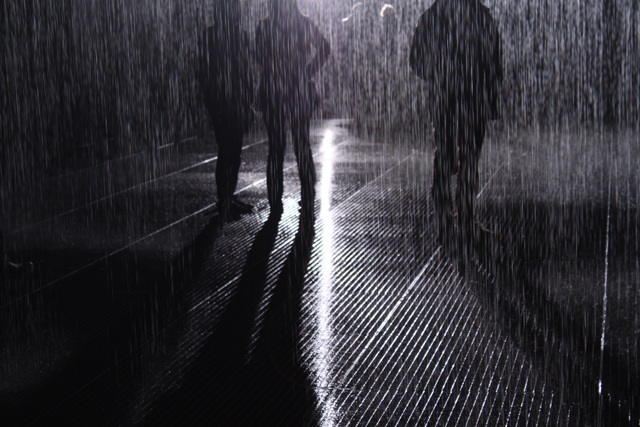rAndom International’s Rain Room at The Barbican

Founded in 2005 by Stuart Wood, Florian Ortkrass and Hannes Koch, rAndom International is a creative artist studio which melds the digital and interactive worlds to create thought-provoking and exciting installation work which often encapsulates aspects of movement or physicality. Now a team of six, the studio is going from strength to strength with many of its elaborate systems and installations popping up all over the art world.
Rain Room sees rAndom International’s latest venture brought to life in the Barbican Curve Gallery. Not a conventional “white cube” space, The Curve’s unique spatial properties only really lend itself well to experiential exhibitions and works; Rain Room is one of those works. As you enter the space which has been encased in black for the purpose of the exhibition you feel a sense of intrigue and wonder as you hear and sense the signifiers of rain. It is not until you reach the end of the tunnel-like expanse that you are confronted by a wall of torrential proportions. The downpour is both daunting and enchanting, not a usual experience we are forced to wrap our minds around. The truth of what we are confronted with is falling water, inside. Lit by a single light on the far side of the gallery, the rain is lit in a glistening shimmer of beauty and is a thing of beauty in itself. However, the real genius of the Rain Room rests in its interactive properties.
The installation is formed of a complex structure of pressure regulators, 3D tracking cameras and hydraulic systems. These factors allow you to pass through the expanse of water without getting wet. The rain literally stops as you enter and you become encased within it. The installation responds to your presence, your movement and your navigation. An impressive feat of engineering, the installation also causes intense emotional reaction. There is something very abnormal about being able to control water in such a way and although it could promote a sense of power and importance, the reality of the situation is an intense vulnerability and a feeling of being at the mercy of machines.
My only criticism of the installation is the shape, formed into a rectangular space, you are very much directed through from one end to another and the whole experience is over prematurely. Had the installation been crafted into a circular shape, it may have felt more comfortable to wander and create one’s own path. However, we can’t really ask for everything; it is a minor criticism and one that is born for the notion that it is such an impressive and overwhelming experience that you do not want it to end, so in that sense it is no criticism at all.
The Rain Room runs from 4th October until 3rd March and has some exciting events to accompany it. On Sunday the 18th November, 2nd December, 20th January and 24th February between 2-5pm audiences will be able to experience a free first-come, first-served collaboration between art and movement, as dancers inter-operate and respond to the Rain Room. This event features Wayne McGregor/Random Dance and is set to a score by Max Richter, and is set to be a mesmerising example of human ability, movement and expression.
A true exploration of human behaviour and interaction, I would recommend that everyone that is unable to commission the studio to recreate the installation in their home. Go to The Barbican to see this wondrous and experiential installation.
Ruth Page
Rain Room is at the Barbican Curve Gallery from 4th October 2012 until 3rd March 2013.























Facebook
Twitter
Instagram
YouTube
RSS